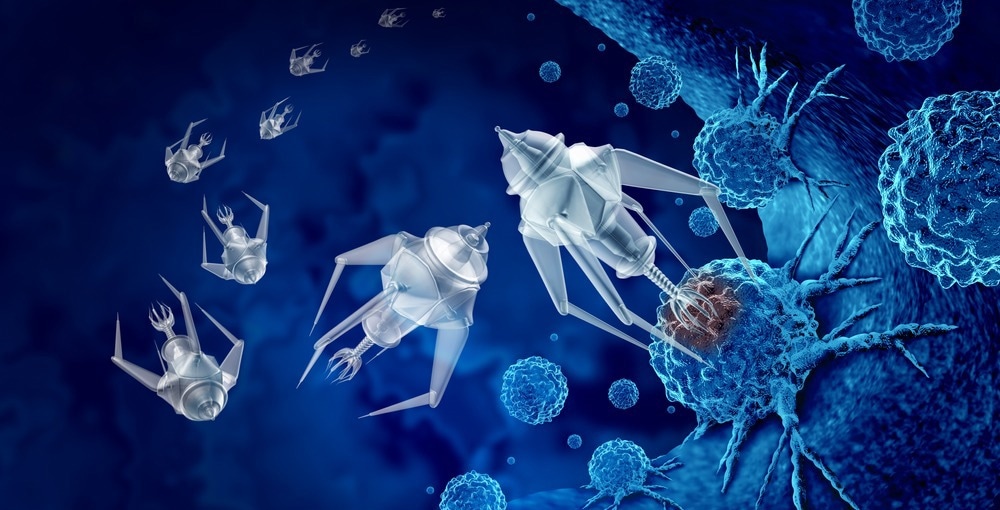In recent years, many research studies have been conducted to assess the therapeutic use of nanomedicines. This is due to their enhanced stability and solubility, ability to overcome transport barriers, and prolonged circulation times.
During nanomedicine development, activity is initially evaluated in vitro studies. Subsequently, the most promising formulations are selected and evaluated in rodents. Rodent in vivo studies are not particularly suitable for the effective large-scale screening of nanomedicines as they are costly and time-consuming.
As a result, significant attention has been given to establishing alternative animal models to assess the activity of nanomedicines in in vivo studies. In this regard, zebrafish have emerged as promising models for the preclinical investigation of nanomedicines. This is due to their availability in large numbers, economic advantages, and ability to assess various biological mechanisms of nanomedicines.

Image Credit: Lightspring/Shutterstock.com
Why are Zebrafish Suitable Model Organisms to Investigate Nanomedicines?
Multiple attributes of zebrafish are highly advantageous for effectively evaluating nanomedicines' use in preclinical settings. For instance, zebrafish demonstrate high fecundity, potentially laying hundreds of eggs daily. They also display well-characterized developmental stages, with a small size of embryos and larvae.
Additionally, zebrafish possess a high level of genetic homology to humans at approximately 70%. Another significant advantage for use as a model organism is their optical transparency, which can be extended to several days through genetic manipulation or chemical-based methods.
Zebrafish also exhibit comparable physiological parameters to their mammalian equivalents. Such as blood composition and organ systems, including the blood-brain barrier, cardiovascular system, and immune system. This will be useful for assessing the biological mechanisms of therapeutic nanomedicines.
Other key benefits of zebrafish include low husbandry costs compared to rodents and rapid ex-utero development. These characteristics make promising zebrafish candidates as model organisms for the preclinical investigation of nanomedicines and can be used to assess toxicity, pharmacokinetics, and efficacy.
Assessing the Toxicity of Nanomedicines Using Zebrafish
Zebrafish demonstrate greater sensitivity to toxic molecules compared to mammalian systems. Also, due to their small size, toxicity testing only requires a small sample of nanomedicine, and several zebrafish samples can be investigated using the dose required to dose only one or two mice. Therefore, zebrafish provide a rapid and economical method to assess the toxicity of nanomedicines in the preclinical setting,
Toxicity can be investigated in zebrafish embryos by assessing phenotypic toxicological endpoints. This includes egg coagulation, missing somites or heartbeat, delayed tail detachment or hatching, decreased pigmentation, and deformities or underdevelopment of the tail, spine, eyes, and ears.
Alternatively, toxicological endpoints typically assessed for adult zebrafish include morphological changes, neurotoxicity, reproductive toxicity, and several other organ-specific toxicities.
The toxicity of various nanomedicines of interest have been investigated using zebrafish as model organisms. For example, the toxicity of RE3+-doped BaF2 nanomaterials was assessed in zebrafish larvae, showing that doped nanoparticles exhibited greater biocompatibility than the undoped counterpart.

Image Credit: topimages/Shutterstock.com
Assessing the Pharmacokinetics of Nanomedicines Using Zebrafish
Zebrafish are optically transparent and can be genetically modified. This allows for the circulation behavior, biodistribution, aggregation behavior, and release profiles of nanomedicines to be assessed through zebrafish models in preclinical studies.
Crucial aspects of the pharmacokinetics of nanomedicines have been better understood by zebrafish in previous studies. For instance, the use of zebrafish has shown that stabilin-2 is a critical receptor for the scavenger endothelial cell (SEC)-mediated removal of large (~100nm) anionic nanoparticles. In comparison, stabilin-1 is also needed to remove small (~6–30 nm) nanoparticles from circulation.
Additionally, a different study aimed to assess the sequestration of fluorescently-labeled nanoparticles by SECs and macrophages using transgenic zebrafish embryos. This study concluded that the inhibition of nanoparticle accumulation through SECs led to an enhanced uptake in macrophages, outlining the competitive nature of nanoparticle clearance.
Assessing the Therapeutic Efficacy of Nanomedicines Using Zebrafish
The characteristics of zebrafish also allow for their use as model organisms to assess the therapeutic efficacy of nanomedicines that target a wide range of diseases, including cancer, neurological disorders, inflammation, diabetes, and obesity.
There have been many studies involving the use of zebrafish to evaluate anticancer nanoparticles. Various methods have been established to test for cancer development and metastases in zebrafish to assess the efficacy of these anticancer nanoparticles, such as detecting fluorescently labeled cancer cells in the animal body.
Recent studies with zebrafish models have demonstrated a high ability of anticancer nanoparticles in treating cancers. The different anticancer nanoparticles investigated in these studies included gold, platinum, polymersome, hydroxyapatite, and silica nanoparticles.
Conclusion
Several studies have demonstrated that zebrafish are effective models in assessing nanomedicines' toxicity, therapeutic efficacy, and pharmacokinetics. Despite the numerous advantages of these animal models in facilitating nanomedicine investigation, they have limited adoption within the pharmaceutical industry.
The limited uptake of zebrafish as a model organism is likely due to a variety of well-established animal models supported by comprehensive historical data, including mice, rats, dogs, and rabbits.
With continued research, there will be a greater understanding of the use of zebrafish as model organisms, and the technologies to use such models will improve. As a result, zebrafish will likely serve as promising models for the preclinical investigation of nanomedicines, helping to drive nanomedicine development and optimization in the future.
Continue reading about zebrafish as a model organism here!
References:
- Al-Thani, HF., et al. (2021). Zebrafish as a Model for Anticancer Nanomedicine Studies. Pharmaceuticals. 14: 625.
- Ruchika, A., et al. (2022). Zebrafish as a powerful alternative model organism for preclinical investigation of nanomedicines. Drug Discovery Today. 27: 1513-1522.
Further Reading
Last Updated: Feb 6, 2023